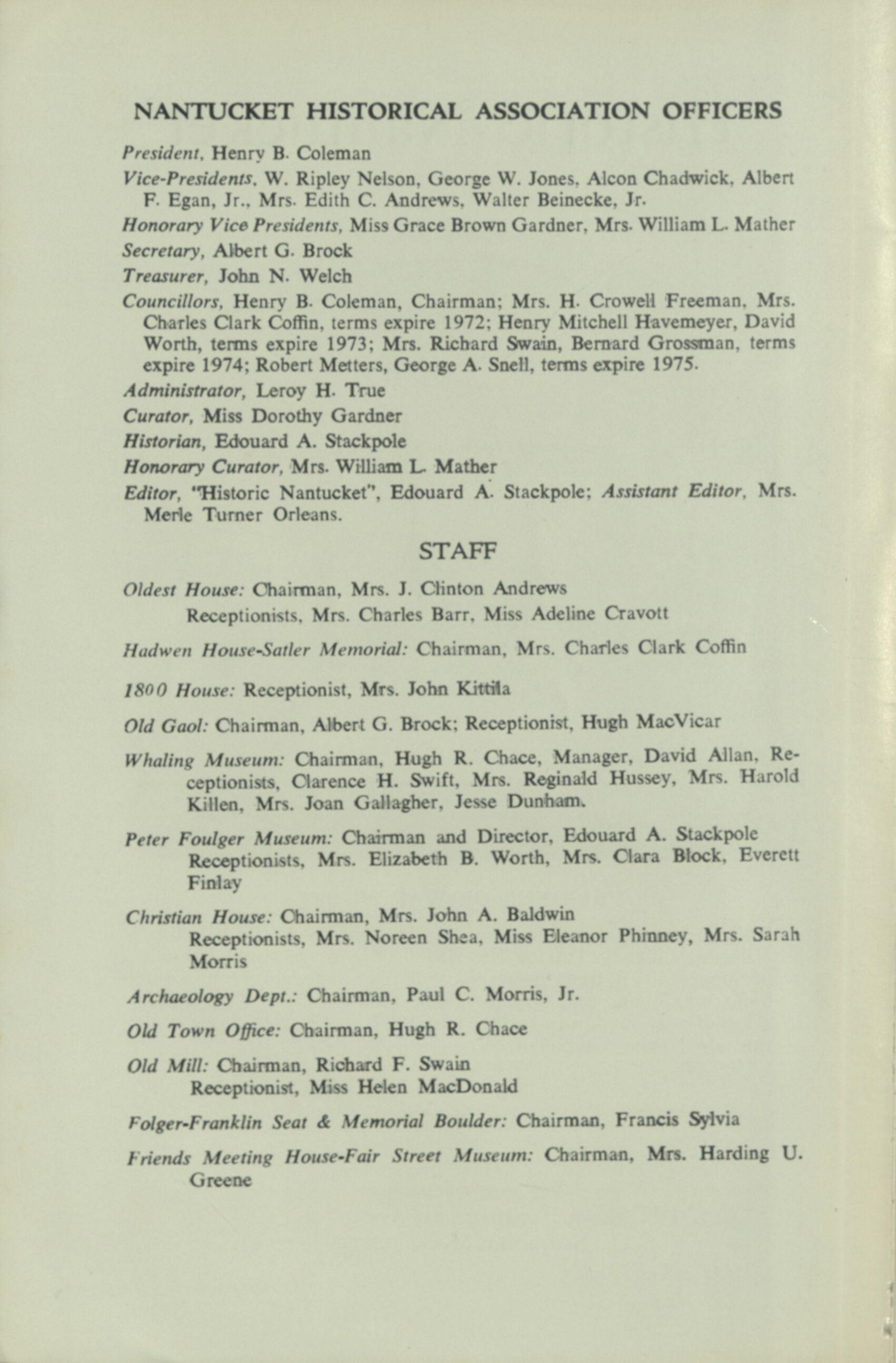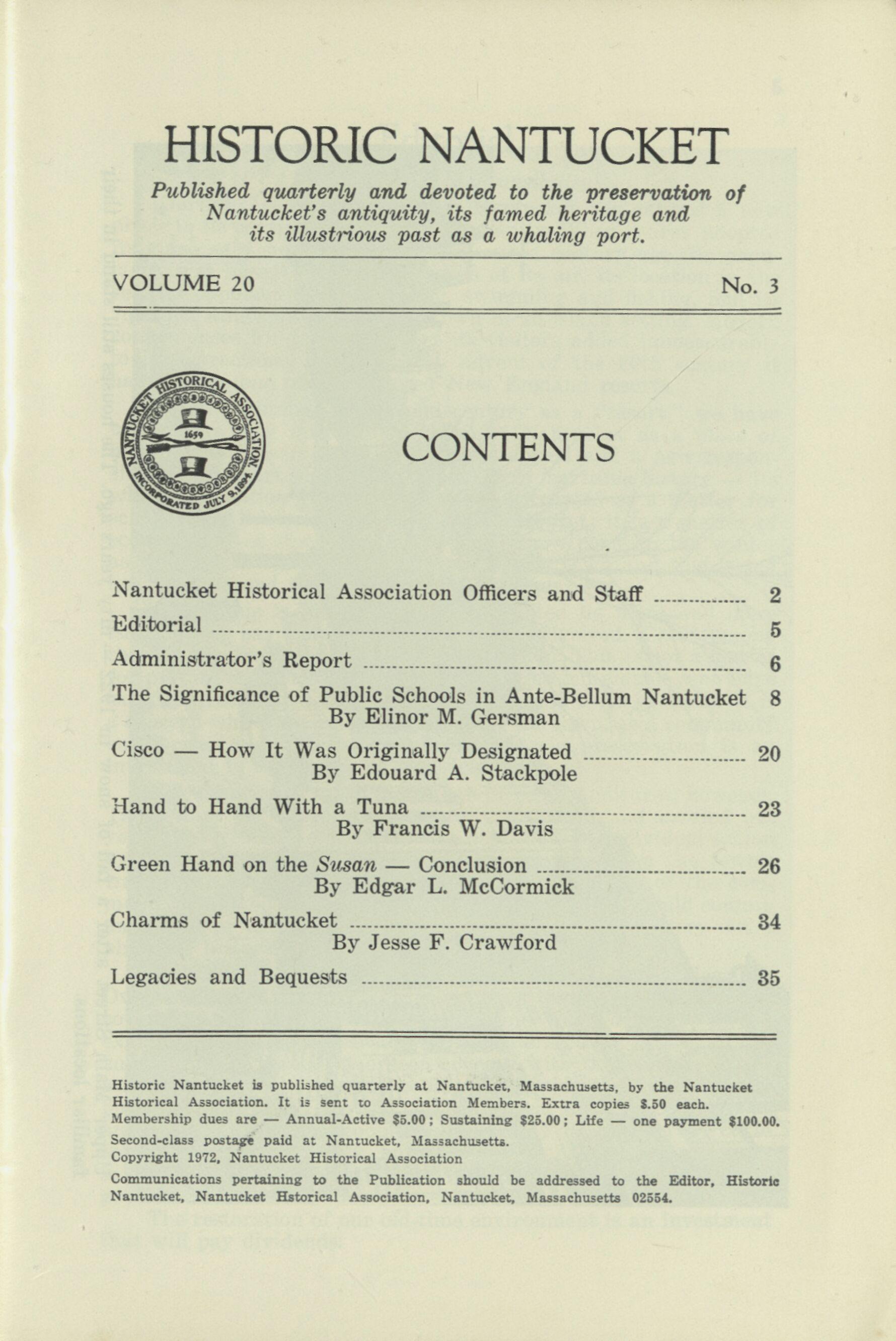
4 minute read
Nantucket Historical Association Officers and Staff
NANTUCKET HISTORICAL ASSOCIATION OFFICERS
President, Henry B. Coleman Vice-Presidents, W. Ripley Nelson, George W. Jones. Alcon Chadwick, Albert
F. Egan, Jr.. Mrs. Edith C. Andrews, Walter Beinecke, Jr. Honorary Vice Presidents, Mis9 Grace Brown Gardner, Mrs. William L. Mather Secretary, Albert G. Brock Treasurer, John N. Welch Councillors, Henry B. Coleman, Chairman; Mrs. H- Crowell Freeman. Mrs.
Charles Clark Coffin, terms expire 1972; Henry Mitchell Havemeyer, David
Worth, terms expire 1973; Mrs. Richard Swain, Bernard Grossman, terms expire 1974; Robert Metters, George A. Snell, terms expire 1975. Administrator, Leroy H. True Curator, Miss Dorothy Gardner Historian, Edouard A. Stackpole Honorary Curator, Mrs. William L- Mather Editor, "Historic Nantucket", Edouard A. Stackpole; Assistant Editor, Mrs.
Merle Turner Orleans.
STAFF
Oldest House: Chairman, Mrs. J. Clinton Andrews Receptionists. Mrs. Charles Barr. Miss Adeline Cravott Hadwen House-Satler Memorial: Chairman, Mrs. Charles Clark Coffin
1800 House: Receptionist, Mrs. John Kittila Old Gaol: Chairman, Albert G. Brock: Receptionist. Hugh MacVicar Whaling Museum: Chairman, Hugh R. Chace, Manager. David Allan. Receptionists, Clarence H. Swift, Mrs. Reginald Hussey, Mrs. Harold Killen, Mrs. Joan Gallagher, Jesse Dunham. Peter Foulger Museum: Chairman and Director, Edouard A. Stackpole Receptionists. Mrs. Elizabeth B. Worth, Mrs. Clara Block. Everett Finlay Christian House: Chairman, Mrs. John A. Baldwin Receptionists, Mrs. Noreen Shea. Miss Eleanor Phinney, Mrs. Sarah Morris
Archaeology Dept.: Chairman, Paul C. Morris, Jr. Old Town Office: Chairman, Hugh R. Chace Old Mill: Chairman, Richard F. Swain Receptionist, Miss Helen MacDonald Folger-Franklin Seat & Memorial Boulder: Chairman, Francis Sylvia Friends Meeting House-Fair Street Museum: Chairman, Mrs. Harding U. Greene
HISTORIC NANTUCKET
Published quarterly and devoted to the preservation of Nantucket's antiquity, its famed heritage and its illustrious past as a whaling port.
Nantucket Historical Association Officers and Staff 2
Editorial
g Administrator's Report 6 The Significance of Public Schools in Ante-Bellum Nantucket 8 By Elinor M. Gersman Cisco — How It Was Originally Designated 20 By Edouard A. Stackpole Hand to Hand With a Tuna 23 By Francis W. Davis Green Hand on the Susan — Conclusion 26 By Edgar L. McCormick Charms of Nantucket 34 By Jesse F. Crawford Legacies and Bequests 35

Historic Nantucket is published quarterly at Nantucket, Massachusetts, by the Nantucket Historical Association. It is sent to Association Members. Extra copies $.50 each. Membership dues are — Annual-Active $5.00 ; Sustaining $25.00; Life — one payment $100.00. Second-class postage paid at Nantucket, Massachusetts. Copyright 1972, Nantucket Historical Association Communications pertaining to the Publication should be addressed to the Editor, Historic Nantucket, Nantucket Hstorical Association, Nantucket, Massachusetts 02554.

Editorial
Our Role and Responsibility
During the past two decades Nantucket has entered a new phase in its continuing life as a community. When it first adopted its guise as a summer resort just over a century ago, its popularity was based on the cleanliness of its air, its location in the sea, its opportunities for sailing, swimming and fishing, and its "quaint" atmosphere as an old town in an island setting. Modern conveniences for the comfort of its visitors added immeasurably to its attractions, and with the advent of the 20th century it had become one of the favored New England resorts.
Now, beginning our second century as a "resort," we have taken on a new mien. Recognition of Nantucket as a place of history has presented us with a new appeal and a new responsibility. The part played by Nantucket in maritime history — its whaling tradition — can no longer be accepted as a matter for scholars and historians to study and interpret; it is a matter of economics — a stock in trade. Visitors now come in the winter as well as the summer. The appeal of this town and this island has gone beyond the seasonal resort complex.
While this is now a factor appreciated by more and more islanders it has definite responsibilities involved. Chief among these is the problem of historic preservation. This is not a matter for private enterprise, so well shown by the individuals who have carefully restored their homes and improved their grounds. It is a concern which must be attended to by the town, as a community enterprise. Every dollar spent for historic preservation is an investment in the future of Nantucket.
The question is much more than mere expenditures, however, There must be a program, carefully prepared and carried out year after year. The citizens have depended on individual action by both residents and by corporations in improving the town's traditional "look." This should be the responsibility of the community as a whole. Every year the annual warrant should contain an article or articles authorizing an expenditure to carry out a phase of historic preservation.
As a place to start let us consider the streets and sidewalks. Over the years the creeping menace of black-top concrete has covered much of the old pavement and cobbled ways. As an example, the dozen crosswalks at the intersections of the streets entering Main Street have been covered with tar, concealing the attractive original stone and cobbles. Restoring them is not costly but the result would provide both an appeal to the eye as well as an investment. Entire cobbled streets may be uncovered; curbstones reset; community pumps replaced; former shops built in replica along the waterfront, and wire services laid underground.
The restoration of our old-time environment is an investment that will pay dividends.






